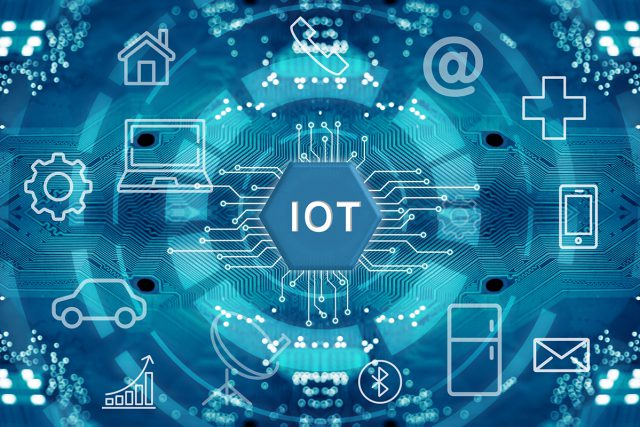Imagine this scenario. You’re out of coffee but with the click of a button or a simple voice command, you reorder a two months’ supply that will arrive the same day. And that almond milk you like? Well, imagine your fridge already knew you were running low on supplies and independently sent the order to restock before you ran out.
The stuff of science-fiction until only recently, internet of things (IoT) technology is beginning to change the way we live and work. Simply put, IoT is a system of interrelated devices—things that can include gadgets, digital objects, or machines, wearables and so on—which have the capacity to send and receive data over a network without human agency or human interaction. As a technology, IoT is novel, and it’s poised to reconfigure a range of sectors and industries—among them, the world of retail.
Amazon is a leader in the consumer-facing space with an ecosystem of apps like Alexa, Fire TV, and the now-defunct Dash Button. Meanwhile, tech-savvy retailers are using IoT to facilitate operations. Smart shelves in stores can detect the status of perishable goods or inventory requirements; radio frequency identification (RFID) sensors can actively track the progress of produce through the supply chain. Retailers can even use IoT to send customers personalized digital coupons when they walk into the store.
As IoT continues to gain traction around the globe, the potential for efficiency-boosting innovation in retail is clear. Less clear, however, is its actual impact on consumer choices and behaviors. Sure, IoT can save time and mental effort, but how does that translate into real-world business outcomes?
This is the question that underscores new research by Vilma Todri and Panagiotis Adamopoulos, both assistant professors of information systems and operations management at Emory’s Goizueta Business School.
They were keen to understand whether consumer behavior is significantly changed under the regime of this new technology as it continues its roll out across the world. Specifically, they wanted to know if IoT technology actually increases demand for products.
And it turns out that it does.
Demand on the rise

“IoT technology in retail is really in its infancy, so understanding its impact on users and business is key,” Adamopoulos said. “We wanted to shed light on these dynamics at this early point to spark interest and generate more debate around how retailers can leverage this technology.”
Together with Stern’s Anindya Ghose, he and Todri put together a large data-set with information about sales of certain products in countries with existing IoT retail markets and in others where the technology has not yet been introduced.

“We needed to take into account these sorts of variables to really understand the effect,” Todri said. “So, we had our control group of non-IoT retail markets, and we were able to compare sales data for the same products in countries where the technology has been adopted.”
The researchers also controlled for time trends, looking at the impact on sale prior to and post IoT adoption.
“Looking at the data over time and pinpointing the exact moment when a product has been made available for sale via IoT sales channels across different countries and at different moments, we were able to infer the effect of the technology on product sales,” Todri said.
In total, they looked at sales for the same or similar products in six countries between 2015 and 2017. They also compared sales across different retailers.
“By analyzing the same sales information for different products in different markets using different channels across the world, we can see differences in the data that can only be attributable to this new technological feature,” Adamopoulos said. And the differences are significant.
Easing the pain of purchasing
Adamopoulos, Todri, and Ghose find that when a product is made available for sale via internet of things channels, sales relative to other products in the same category increase by between 13 and 14 percent. Interestingly, the surge in demand for these products does not translate into a dip in demand for other, similar products that can only be purchased via other, more conventional means. In other words, IoT purchasing processes are increasing sales in one area without cannibalizing sales elsewhere.
They put this down to three factors.
First is the ease of consumption. As Todri puts it: “IoT takes the friction out of buying something. You have to key in your personal information and payment details just once and never again thereafter. It reduces the mental effort and time involved in interacting with the retailer.”
Then there’s what Todri calls the “endless supply” effect. “When you start to run out of something, you can simply reorder it at the click of a button or using a simple voice command,” she said. “You get that reassuring feeling that you have a seamless, endless supply of something that you need. And that makes it more likely you’ll shop more for this particular product this particular way.”
Finally, there’s the pain factor.
“Reaching for your wallet and punching in your credit card details is intrinsically onerous to us as consumers. We have a heightened awareness of the spend—of the fact we are depleting our income. With IoT it’s all automated, so your purchase pain is reduced,” Adamopoulos said. “In reality, nothing has changed in practice. As a consumer, you are paying the same price you would if you went to the supermarket. But mentally, you feel like you’re not paying and that you have the confidence of having a seemingly endless supply of something important to you.”
New ideas that are here to stay
IoT technology in retail has the potential to deliver a win-win dynamic, Todri said. Consumers save time while retailers see a significant increase in demand; the technology facilitates the sales process which in turn facilitates the sales themselves. According to their findings, it makes “total sense” for retailers to look at integrating this technology as it becomes increasingly available.
Considering this, they caution that transparency and corporate responsibility should remain front of mind.
“Countries have been uneven in their take up of IoT. France, for instance, was slower than Germany because of concerns about the law, and ensuring that consumers have full and easy access to information about prices,” Todri explained.
It would be a mistake, Adamopoulos warned, for retailers to hike prices for products available for purchase via IoT. Similarly, as the technology becomes more ubiquitous, we are likely to see certain refinements. These might include things like the option to cancel orders if the price is excessive or has increased since the last purchase.
“IoT in retail is really just beginning. And the opportunities to leverage its many benefits will be felt by consumers and retailers alike, provided we understand the importance of ethical business practices and transparency,” the researchers noted. “But as a technology, we are confident it has the potential to disrupt and reshape markets all over the world. These are exciting new ideas, and they’re going to stick around for a while.”











